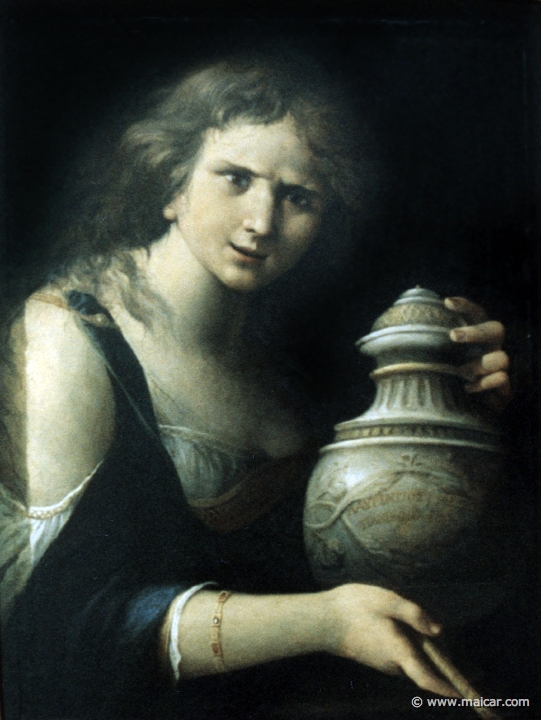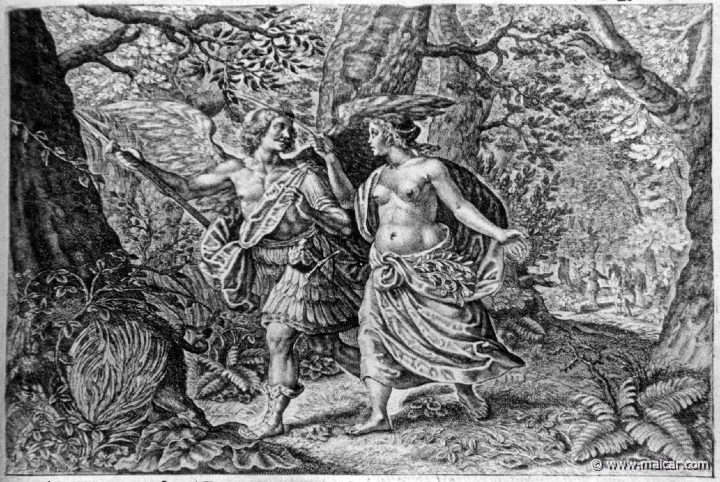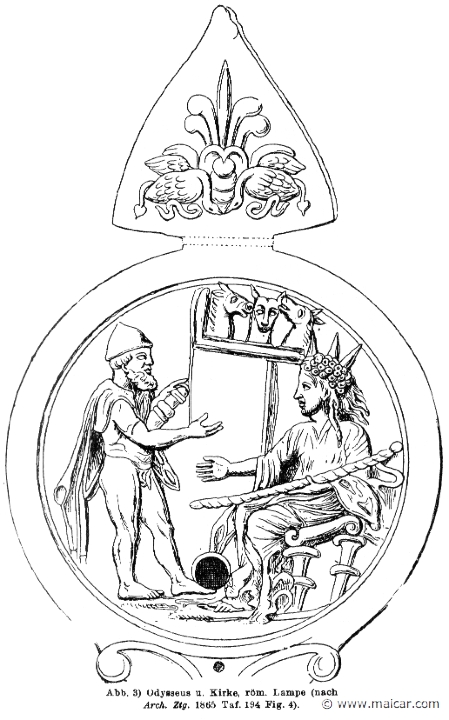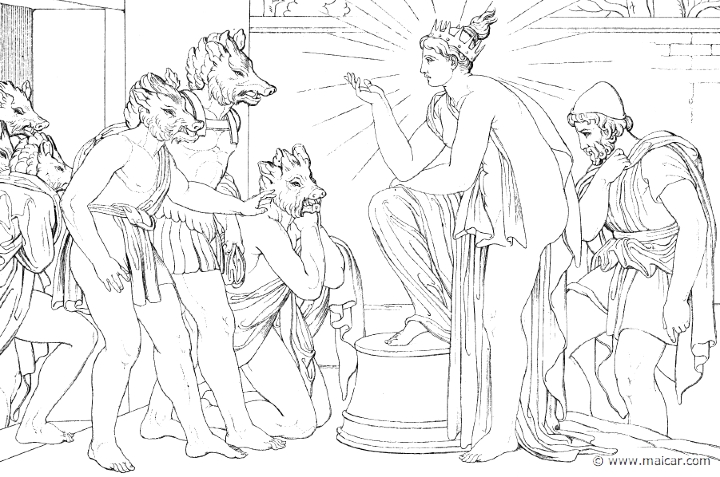|

|
0808: Circe. Painting by Lorenzo Garbieri, 1588-1654. Pinacoteca Nazionale, Bologna.
|
|
Circe is the witch living in the island of
Aeaea, who was visited by the ARGONAUTS, and Odysseus.
Formidable witch
Circe was a powerful witch who, with the help of
herbs, muttering incantations, or praying to her
weird gods, could turn men into animals, or create
unsubstantial images of beasts. She was able to
darken the heavens by hiding the moon or the sun
behind clouds, and destroy her enemies with
poisonous juices, calling to her aid Nyx, Chaos, or Hecate. In her presence,
and because of her enchantments, the woods could
move, the ground rumble, and the trees around her
turn white. But as witchcraft may make a victim also of him
or her who practises it, the nights of Circe could
be wasted in fear because of the uncontrolled
visions that filled her house. And so, for example,
the walls and chambers of her palace could seem to
be bathing in blood, while fire could seem to
devour her magic herbs. That is why it was a relief
for her when daylight came, and she could bathe and
clean her garments, forgetting the scaring nightly
visions.
Surrounded by beasts
If these were visions, those who came to her
abode could hallucinate as much as she did, and if
not, her world was in fact transformed. For Circe
is said to have been surrounded by all kinds of
beasts which cannot be seen elsewhere, having an
appearance that reminds of what earth produced out
of primeval slime. And yet, when others came to the
palace of Circe, they also saw many beasts, but of
the regular kind, that is, such as lions, bears and
wolves, which however, acted as domesticated
animals, showing their kindness by wagging their
tails. Some say that these were actually the
drugged victims of Circe.
The abode of Circe
The witch Circe, whose hair resembled flames,
lived in Aeaea, an island which could be located
off the western or eastern coast of Italy, where
she was brought by her father Helius. The name of this
elusive island is what some call a palindrome, for
it is the same when read backwards or forwards. The same could be said of the simpler name Aea,
which is the name of the city whence King Aeetes, Circe's brother
or perhaps father, ruled Colchis (Caucasus). And as Aeetes is said to come
originally from Corinth,
some have called her "Circe of Corinth", but those who
have thought Aeaea to be an island west of Italy
have called her "Ligurian Circe". However, it has
been said that on the larger of the two islands
called Pharmacussae, which are close to Salamis off
the coast of Attica, the tomb of Circe could be
seen in ancient times. Still others have suggested that the mountain
Circaeum, which was in ancient times the southern
boundary of Latium in Italy, could have been the
abode of Circe, for this mountain, being surrounded
by marshes and sea, looks like an island. And there
was in Circaeum in ancient times a little city and
a temple of Circe, and visitors and tourists were
shown a bowl, which the locals said had belonged to Odysseus.
Daily life in Aeaea
Some of those who visited Aeaea have told that
Circe, who lived in a house made of stone in the
middle of a clearing in a forest dell, used to sit
on a throne wearing a purple robe and a golden
veil. They said that her attendants were NEREIDS and NYMPHS, who had for only
task to sort out the plants and flowers of Circe's
herbarium, and put them in separate baskets.
Besides supervising them, Circe, while singing
beautifully, wove delicate and dazzling fabrics,
which is one of the goddesses' favorite
occupations. Others have said that Circe was
attended by four maids, one who threw covers over
the chairs, another who drew silver tables up to
the chairs, placing golden baskets on them, another
who mixed the wine, and a
fourth who fetched water and lit up the fire to
warm it.
|

|
2824: Circe and Picus. Les METAMORPHOSES D’OVIDE EN LATIN ET FRANÇOIS, DIVISÉES EN XV LIVRES. TRADUCTION DE Mr. PIERRE DU-RYER PARISIEN, DE L’ACADEMIE FRANÇOISE. MDCLXXVII.
|
|
In love with Glaucus 7
Some say that Circe fell in love with Glaucus 7, brother of the NEREIDS, who some say had once been a mortal fisherman, but afterwards became a sea-deity by chewing a plant. However, Glaucus 7 loved Scylla 1, who was a most
beautiful young woman, and when she, as it was her
custom, went to bathe in the sea, Circe, out of
jealousy, poisoned the water with her magic drugs.
This is how the beautiful girl became a monster
with the face and breast of a woman but having in
her flanks six heads and twelve feet of dogs, and a
danger for ships passing the strait of Messina
between Sicily and Italy.
In love with Picus
It ws in the neighborhood of Circaeum, when the witch Circe was once gathering herbs, that she met Picus, and instantly fell in love with him. This Picus, son of Cronos, was
a demigod living on the Aventine hill. He also used
powerful drugs and practised clever incantations,
being able to play many tricks. Circe loved him,
but he, being in love with the singer Canens,
daughter of Janus, refused her, not imagining what
a scorned woman was able to do: Turning twice to
the east and twice to the west while touching Picus
thrice with her wand as she sang her charms, Circe
turned him into a woodpecker. And after this, she populated the surroundings
with many beasts, for Picus' friends coming to her
and asking for the young man, were all transformed
by her into animals of many shapes, while Canens,
in grief for Picus' absence, melted away in tears
and vanished.
The ARGONAUTS in
Aeaea
|

|
RII.1-1197: Odysseus and Circe. Wilhelm Heinrich Roscher (Göttingen, 1845- Dresden, 1923), Ausfürliches Lexikon der griechisches und römisches Mythologie, 1884.
|
|
The island of Circe was visited by the ARGONAUTS, when they
were escaping the Colchian fleet. Some say that Medea, who was with Jason and the ARGONAUTS, wished to
visit her aunt, but others have said that it was
the ship "Argo" itself that instructed them to come
to Circe, and be purified for the assassination of Medea's brother Apsyrtus.
Others say that Zeus himself was seized by wrath when he learned about
the ruthless murder of Apsyrtus, and he ordered
that the ARGONAUTS should be cleansed by Circe. In any case, Medea and the ARGONAUTS could leave
Aeaea purified by the witch.
Odysseus discovers
Circe's abode
It was in great despair and exhaustion that Odysseus and his crew
arrived to Aeaea, for they had barely escaped the
Cyclops Polyphemus 2, and the cannibals in the land of the Laestrygonians.
After resting on the beach for three days, Odysseus, who had seen a wisp of smoke in the distance, divided his men in two groups, and sent Eurylochus 3 with twenty two men to explore the terrain.
Odysseus' men turned
into pigs
When Eurylochus 3's party found Circe's house, the witch invited them to enter, and all of them followed her except captain Eurylochus 3, for he, suspecting a trap, stayed outside. Those who came in Circe treated with a mixture of cheese, barley meal, and honey flavoured with Pramnian wine, to which she added a powerful drug to make them forgetful of their native land. When they had eaten their meal, she struck them with her wand, and driving them off, put them in the pig sties, for they now looked like swine and grunted exactly like pigs, though their minds were unchanged. But some have said that she turned these men
into wild beasts. When this happened, Eurylochus 3 hastened back to the beach and reported to Odysseus that his whole
party had vanished. And when Odysseus decided to go to Circe's house, there was no way to convince Eurylochus 3 to make his way back to the house of the witch.
Hermes helps Odysseus
So Odysseus went by
himself, and in his way to Circe's he met Hermes, who, while giving
him an antidote (a plant called Moly with black
root and white flower) that would rob Circe's drugs
of its power, told him to oppose his sword to her
wand, for she, fearing for her life, would shrink
from him in terror, and invite him to her bed. Hermes also advised Odysseus to accept
Circe's favors while making her swear an oath not
to try any more tricks, for otherwise, Hermes said, she could
rob him of his courage and manhood.
Friendship restores the crew to its original
shape
That is how Odysseus could take Circe by surprise, and when she was
threatened by him she remembered that Hermes had once told her
of the arrival of this man to her island. And as Hermes had predicted, she
invited him to her bed:
"... so that
in love and sleep we may learn to trust one
another." (Circe to Odysseus. Homer, Odyssey 10.335).
... and then Odysseus persuaded her
to free his comrades. Circe then smeared their pig
heads with a salve, and they became men again, some
say even more handsome and taller than before. And
from that moment there was friendship between Circe
and Odysseus' crew, and
charmed by the hospitality of the witch they stayed
with her for a whole year.
|

|
Circe turns Odysseus' comrades into swines | od199gen: "Now when she had given them the potion, and they had drunk it off, then she presently smote them with her wand, and penned them in the sties. And they had the heads, and voice, and bristles, and shape of swine, but their minds remained unchanged even as before." (Hom.Od.10.236). Bonaventura Genelli (1798 – 1868).
|
|
New journey
When the year had passed, and Odysseus beseeched her
to keep her promise and send him home to Ithaca,
Circe told him that before she could do that, he
would have to make a journey to the Underworld and
consult the soul of the seer Tiresias about the
outcome of his wanderings. And this was the first time a ship sailed to Hades, blown by the North Wind (Boreas 1, see WINDS), and Odysseus was given by
Circe all the instructions necessary to reach the Underworld, where to beach his boat, and how to proceed in order to meet the souls of the dead (see Map of the
Underworld and Odysseus).
Predictions and instructions
Returning from Hades, the ship of Odysseus put in at
Aeaea once more, where the whole crew sat with
Circe, and feasted on a rich supply of meat and wine. At night, Odysseus and Circe
retired, and before his departure the day after,
she described for him the dangers that still
awaited, instructing him as how to avoid the SIRENS and still listen
to their enchanting song, and warning him, among
other things, about the rocks that are the abode of Scylla 1 and Charybdis.
(Too) many children
Circe, they say, had children by Odysseus, perhaps too
many considering the time he spent in Aeaea, but
goddesses, and even witches, may perform miracles.
|